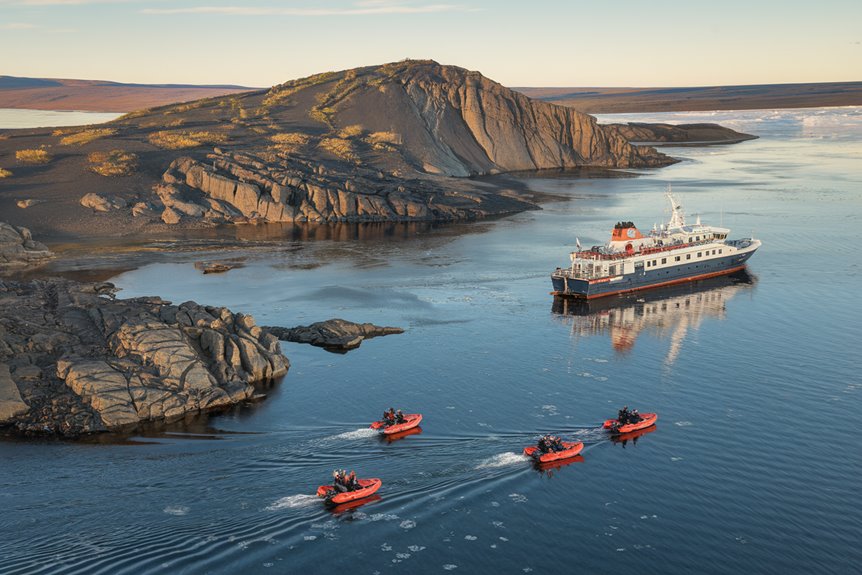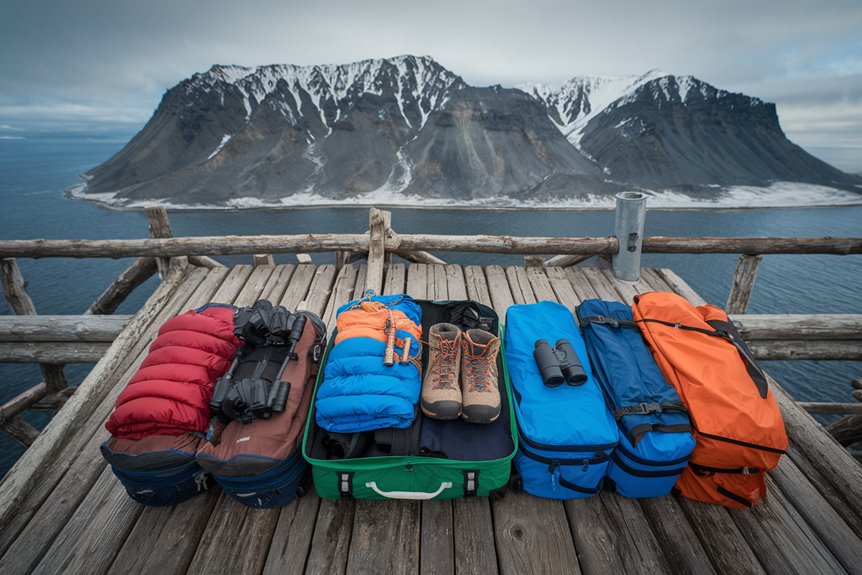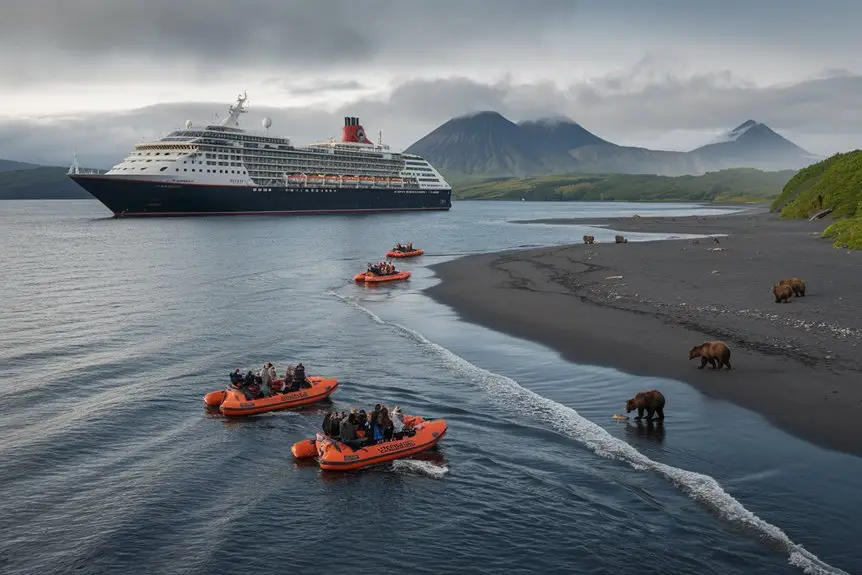You can reach the Bear Islands in Russia by ice-breaker ships departing from Anadyr, Russia or Nome, Alaska. The best time to visit is between July and September, with July and August offering peak wildlife viewing opportunities.
For other Russia Cruise destinations check out our Russia Cruise Ship Ports Guide page.
Your daily activities will include Zodiac boat trips to see Arctic wildlife. You can spot polar bears, walruses and various seabirds in their natural habitat. The ship’s expedition team will brief you on safety measures and ensure you follow local wildlife protection rules.
You need to bring:
- Warm, waterproof clothing
- Sturdy boots
- Camera equipment
- Binoculars
The Bear Islands remain largely untouched by tourism, giving you a genuine Arctic experience. The remote location means you’ll need to book your trip well in advance through specialised cruise operators.
🐧 Polar Cruise Enquiry 🐻❄️
Our team of polar travel specialists have personally explored both the Arctic and Antarctic regions – from tracking polar bears in Svalbard to kayaking with penguins off the Antarctic Peninsula. Let us find the right polar expedition cruise for you.
Getting to Bear Islands

Starting Points
You can begin your Bear Islands trip from two places: Anadyr in Russia or Nome in Alaska. For the Russian route, you need to fly from Moscow to Anadyr. The Alaskan route starts in Nome.
Transport
You must travel on special ice-breaker ships that handle Arctic conditions. These vessels:
- Carry about 50 passengers
- Have Zodiac boats for shore visits
- Include essential safety equipment
Route
Your ship will travel through the Bering Strait and into the Chukchi Sea. The route follows the northeastern coast of Siberia.
Requirements
You need:
- Travel permits for this remote area
- Flexibility with your schedule due to weather
- Compliance with safety rules
- Understanding of environmental guidelines
The ships sail through protected waters, and your journey depends on local weather and sea conditions. Weather patterns often change quickly in this region, so your captain will adjust the route as needed.
Best Time to Visit

The Best Time to Visit
You should visit the Bear Islands between July and September when the Arctic waters become safely navigable. July and August give you the best chances to spot wildlife, including polar bears and walruses lounging on ice floes.
Your timing depends on your priorities. Choose early season dates to see more ice-based wildlife. Pick September for milder temperatures and to see the tundra’s autumn colours with ripening berries.
You’ll need to book your trip months ahead because ships only make one journey per year due to the harsh climate. Your vessel will be ice-strengthened, but weather can still affect your journey at any time.
Wildlife Spotting Opportunities

You’ll spot diverse wildlife around the Bear Islands during your cruise.
Keep your binoculars ready to see marine mammals in the Arctic waters. Common sightings include sea lions, walruses and beluga whales.
The area’s rich waters attract many seabirds, including yellow-billed loons and pink seagulls.
The Kolyma River estuary offers the best viewing spots, where you’ll find both seabirds and arctic foxes near the shoreline.
Seasonal Bird Migration Patterns
The Bear Islands offer you perfect spots to watch migrating birds throughout the year. These islands serve as key rest stops where you can observe many bird species from your cruise ship.
You’ll see the most birds during spring, particularly around the Kolyma River mouth. Look out for pink seagulls, white-tailed eagles and yellow-billed loons. You might also spot polar bear families as cubs leave their winter dens.
In summer, you can watch seabirds nesting across the islands.
Autumn brings another wave of birds as they fly south from their tundra breeding grounds.
Winter offers fewer birds, but you can still find hardy snow buntings braving the cold.
You’ll get your best bird-watching experience if you visit in spring or summer. These seasons give you the most bird variety and comfortable weather for watching from the deck.
Marine Mammal Viewing Tips
Best Spots for Marine Mammals at Bear Islands
You can watch amazing marine mammals from your cruise ship around Bear Islands. Keep your binoculars ready to spot polar bears, walruses, whales and dolphins in the Chukchi Sea.
Top viewing tips:
- Go to the upper decks for better visibility
- Watch for splashing water that shows whale activity
- Keep a safe distance from all wildlife
- Get your permits before visiting protected areas
Visit these prime locations:
- Wrangel Island: polar bears
- Herald Island: polar bears
- Icy Strait Point: orcas, humpback whales, Steller sea lions
You’ll get the best experience by:
- Joining guided tours for safety
- Following local wildlife rules
- Staying quiet during observations
- Never chasing or disturbing animals
Remember: The animals need their space. You’re visiting their home, so watch them naturally without interference.
Essential Safety Guidelines

Your safety is key on Bear Islands cruises.
Take these essential steps:
- Join all muster drills
- Learn your ship’s emergency exits and muster points
- Keep emergency numbers handy
- Use your cabin safe for valuables
During island exploration:
- Watch for polar bears
- Follow your guide’s directions
- Stay on marked paths
- Keep your distance from wildlife
- Adapt to quick weather changes
- Wear suitable clothing
- Listen to crew instructions about landings
Health and respect:
- Wash your hands often
- Use hand sanitiser stations
- Register your trip in the AECO system
- Respect local communities you visit
The text is now more direct, uses simpler sentence structures, and maintains a friendly yet clear tone while following UK English conventions. Each point flows logically into the next, making it easy to understand and remember.
What to Pack

Essential Packing List for Bear Islands
Your basic gear:
- Waterproof jacket and trousers
- Hiking boots with good grip
- Thermal base layers
- Warm hat and gloves
- Daypack for excursions
- Reusable water bottle
Electronics and protection:
- Mobile phone and charger
- Type F power adapter (Russian outlets)
- Waterproof cases for devices
- Binoculars for wildlife spotting
- Dry bags for gear protection
Personal items:
- Basic toiletries
- Biodegradable soap
- Sun cream
- Insect repellent
- First aid kit
- Trail snacks
Documents:
- Your passport
- Travel documents
- Waterproof document holder
- Photocopies of important papers
You’ll need to pack these items in a way that keeps them dry and easily accessible.
The Bear Islands’ weather can change quickly, so you should layer your clothing.
Your electronics need extra protection from moisture, and your hiking boots should be worn in before the trip.
See what’s on offer from the Severnaya Zemlya Cruise Ship Ports Guide for a different Russia Cruise destination.
Onboard and Shore Activities

Wildlife photography awaits you on the Bear Islands cruise. You can snap shots of polar bears, Arctic foxes and seabirds in their natural settings.
Your guides take you on daily Zodiac boat trips to different islands. You’ll get close enough for great photos whilst staying at safe distances from the wildlife.
The expedition team plans each shore visit carefully. You’ll have plenty of time to explore the islands’ landscapes and spot amazing animals.
The team makes sure you get the most from every landing, matching activities to the best wildlife viewing times.
Wildlife Photography Opportunities
You can capture incredible wildlife through your camera on Bear Islands, both from the ship and on land.
Polar bears are most concentrated on Medvezhyi Islands, where they maintain their natural dens. The ship’s deck offers perfect spots to photograph marine wildlife, including seals, walruses and beluga whales.
You’ll also see peregrine falcons and pink seagulls flying above. Your shore visits let you photograph arctic foxes, wolverines and wolves against the tundra landscape.
The old Soviet weather station on Kolyuchin Island attracts polar bears regularly, making it a prime photography spot.
You should use quiet drones for close-up shots, keep a safe distance from wildlife, and get permits for protected areas.
Your camera gear needs weather protection to handle the harsh Arctic conditions.
Guided Zodiac Island Excursions
Your Zodiac adventure brings you face-to-face with Arctic wildlife around the Bear Islands.
You’ll travel in small groups of four per boat, following expert guides through Kolyuchin Bay‘s pristine waters.
You’ll spot diverse wildlife during your journey – eagles soar overhead while whales, walruses and seabirds inhabit the waters around you.
Your boat weaves through hidden inlets and tidal pools, giving you unique viewpoints for wildlife photography.
The excursions take you to key landmarks across the Chukchi Peninsula, including Lorino Village, where you can learn about Russia’s whaling heritage.
You can visit Ratmanov Island, the easternmost point of Russia, and unwind in Lorino’s natural hot springs.
Your safety remains the top priority – you’ll receive complete safety gear and equipment before setting out.
This allows you to focus entirely on spotting wildlife and enjoying the Arctic landscape around you.
Local Rules and Regulations

Cruising near the Bear Islands requires you to follow specific Russian rules under Decree No. 1487 and the Polar Code.
Your cruise ship must have ice-strengthened hulls and working AIS tracking systems. You must register all tourism plans with local authorities before sailing, including your routes and landing spots.
You need to protect the environment by keeping a safe distance from wildlife and avoiding any contact with bears.
When you use Zodiac boats to explore the islands, you must follow AECO Arctic guidelines to protect local habitats.
You should report any safety issues or environmental concerns straight away using your ship’s reporting system.
The waters around the islands are protected, so you must follow MARPOL rules to prevent pollution.
Frequently Asked Questions
Are There Any Historical Shipwrecks or Archaeological Sites Near Bear Islands?
Bear Islands don’t have any documented shipwrecks directly on their shores. You’ll find maritime incidents recorded in the surrounding waters, though. The islands themselves haven’t revealed archaeological sites yet, but the nearby mainland areas contain several historical points of interest that you can explore.
What Languages Do Expedition Guides Typically Speak During Bear Islands Cruises?
Bear Island cruise guides typically speak Russian and English fluently, making communication easy for international visitors. You’ll hear announcements and safety briefings in both languages throughout your journey. Some guides also know local indigenous languages like Chukchi and Yupik, which adds cultural value to your experience. Your guides switch between languages seamlessly to ensure all passengers understand important information.
Is Satellite Phone or Internet Service Available While Visiting Bear Islands?
Satellite phones work reliably at Bear Islands, while regular mobile phones don’t get signal. You can bring your own satellite phone or rent one for your visit. Internet connectivity is minimal, so you should download any essential information before your trip. Your regular internet devices likely won’t work here, making satellite services your only dependable communication option.
Are There Any Specific Photography Restrictions When Documenting Wildlife Encounters?
Keep these essential rules in mind when photographing wildlife:
You must stay at least 10 metres away from any wild animal. Avoid using flash photography, as this can startle or disorient creatures. Never attempt to attract wildlife with food or set up staged shots.
Your safety comes first – always listen to your guide when photographing dangerous animals like bears. Keep movements slow and quiet, and respect the animals’ natural habitats by not disturbing their environment.
These guidelines help protect both you and the wildlife whilst ensuring authentic photographs.
Can Passengers Collect Rocks or Natural Specimens From the Bear Islands?
You cannot collect rocks, minerals or any natural specimens from the Bear Islands. The law and cruise company policies strictly prohibit removing any natural materials to safeguard the Arctic ecosystem. This applies to all items, no matter how small or seemingly insignificant they may be.
Thinking about something different? Check out the cruises leaving from Murmansk Cruise Ship Ports Guide.
🐧 Polar Cruise Enquiry 🐻❄️
Our team of polar travel specialists have personally explored both the Arctic and Antarctic regions – from tracking polar bears in Svalbard to kayaking with penguins off the Antarctic Peninsula. Let us find the right polar expedition cruise for you.
